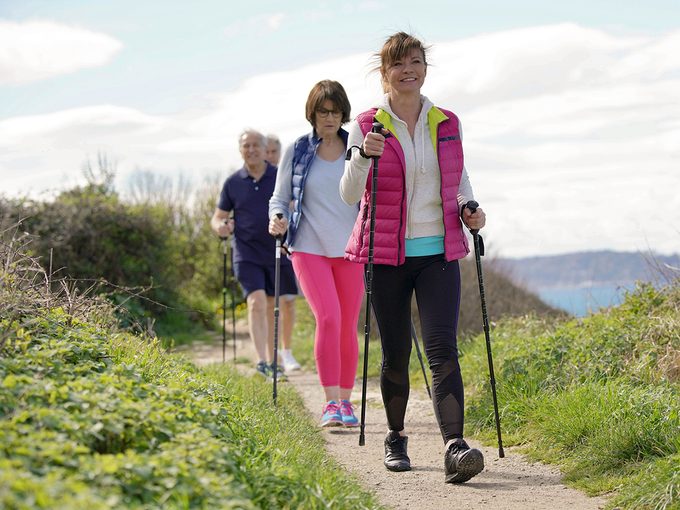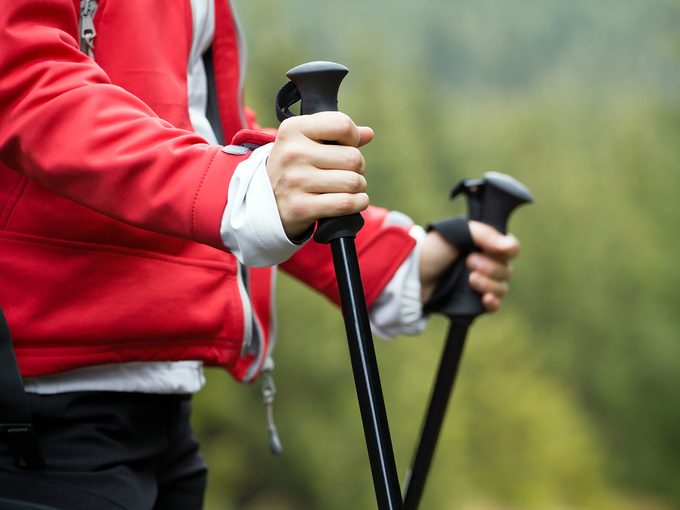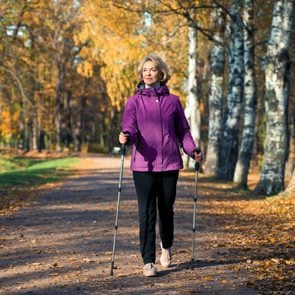The Easiest Way to Get a Full Body Workout From Walking
Have you ever seen someone strolling down the sidewalk holding what look like ski poles—in the dead of summer? If so, you’ve witnessed Nordic walking in action. Providing an excellent full-body workout, it's one of the best ways to max out the benefits of your daily constitutional—and it's gaining followers across the country.

What is Nordic walking?
Nordic walking turns a standard walk into a full-body workout by incorporating specialized walking poles. Developed in Finland as an off-season activity for cross-country ski athletes, it’s now one of Canada’s fastest growing activities.
According to Mandy Shintani, a Vancouver-based occupational therapist and gerontologist, Nordic walking’s popularity has surged since the pandemic kicked off. At a time when gyms were off-limits, she says Nordic walking presented a fantastic opportunity to get exercise and socialize outdoors. “Every year there’s been increasing interest, but in [2020-2021] we saw the biggest jump with a 25 percent increase in pole sales and interest in courses,” Shintani says.

Health benefits of Nordic walking
When using the specialized poles (one for each hand), your upper body is performing an action similar to cross country skiing, one of the best activities for cardiovascular fitness. In addition to getting your blood pumping, it’s engaging 70-90 percent of your muscles (including the abdomen) in a core-strengthening, full-body workout. Studies show Nordic walking burns an average of 20 percent more calories than regular walking (with some subjects burning as much as 46 percent more calories).
It’s also appealing from an accessibility standpoint: Nordic walking poles provide stability for those who suffer from hip and knee osteoarthritis, and any condition affecting balance such as Parkinson’s disease. Simply having those two extra points of contact with the ground reduces the risk for falls, and makes Nordic walking an attractive option for those concerned about maintaining mobility and independence. Some even find Nordic walking poles a more effective rehabilitation option than using a walker or cane.
But the health benefits of Nordic walking extend beyond the physical. Compared to your typical stroll, Nordic walking can have a positive impact on your sense of well-being.
“It turns walking into power walking, and because you’re getting a greater cardio workout, you’re producing more endorphins, which leads to better moods. I know of some mental health units that have used it as a way to treat depression,” says Shintani.
And you can’t ignore the convenience factor. With a set of walking poles, any location transforms into a gym; plus, being in the great outdoors provides its own health benefits.

A beginner’s guide to Nordic walking
Just as you wouldn’t use a tennis racket for squash, you can’t use conventional ski poles for Nordic walking. Nordic walking poles are designed differently than their skiing (and even hiking) counterparts, and can be found in drug stores, sporting good shops and online.
Whereas hiking poles are held straight up and down with bent elbows, Nordic walking poles ought to be used on a diagonal angle, with a straight elbow. Because there is a technique to it, it’s best to check in with your local community centre as many hold introductory classes and weekly walking groups to help you get started.
“It’s not much different from other sports in that if you can get proper instruction, you’ll reap more of the health benefits. The more you do the technique correctly, you’ll get a better a workout,” notes Shintani.
If you’d like to give it a go for rehabilitation purposes, professionals including occupational therapists, physiotherapists and kinesiologists ought to be able to provide guidance. (In some provinces rehab will require a doctor’s referral, so you may need to start this process with a visit to your general practitioner.)
As keen as you may be to get going, take care not to overdo it. One of the most common mistakes people make when Nordic walking is to exceed their walking tolerance. Since Nordic walking engages the entire body, it’s quite likely you’ll be using muscles that don’t get a regular workout. Take the time you need to acclimatize or you’ll put yourself at risk for injury.
“It’s an activity that’s hard to understand until you try it yourself. Not until people get the poles in their hands do they get it, but you’ll get to a point where just love using them,” Shintani says.
Now that you know what Nordic walking is, find out what happens when you start walking 10,000 steps a day.






